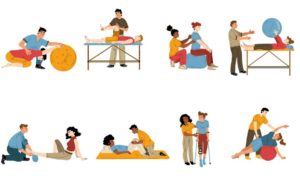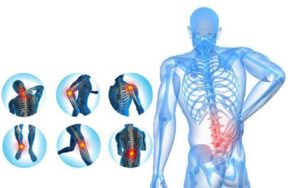What is Physiotherapy?

Physiotherapy, a natural and secure method for alleviating pain and enhancing mobility, stands as a fundamental treatment approach. It aims to mitigate discomfort, fortify muscles, improve range of motion, and ensure that your treatment regimen remains devoid of any undue discomfort or pain. Engaging in both in-office and at-home exercises is imperative for the effectiveness of your physiotherapy. By cultivating proper posture, robust muscles, and resilient joints, you fortify your capacity for balance, endurance, and pain mitigation. An eminent aspect of this method lies in its ability to circumvent the adverse effects often associated with prescription medications and surgical interventions.
Within the realm of physiotherapy, a practitioner emerges as a specialist in movement, well-versed in scrutinizing mobility challenges spanning activities like walking, running, jumping, bending, and stretching, among others. Pain alleviation, muscle strengthening, and functional amalgamation constitute the three pivotal tiers of physiotherapeutic intervention.
It is a misconception to apprehend physiotherapy as a potentially painful or detrimental procedure. Quite the contrary, its primary objective lies in the diminishment or eradication of pain altogether. Once your physiotherapist comprehends your unique requisites, they embark on crafting a tailored care plan, directed at assuaging your discomfort and realizing your aspirations. This plan encompasses exercises aimed at augmenting your strength, agility, equilibrium, and overall mobility, along with a regimen for at-home practice. Your therapist’s dedication to your recovery parallels your own, as they fervently encourage you to accomplish the objectives outlined at the outset. Ultimately, the outcome of physiotherapy equips you to lead an active life devoid of the constraints imposed by pain. This transformation hinges upon your application of the knowledge gleaned from your sessions to your day-to-day experiences. If you find yourself uncertain about what to anticipate from physiotherapy, whether you are contending with the aftermath of an accident, recuperating from surgery and grappling with the restoration of your range of motion, or seeking assistance in reinvigorating your knees for evening strolls or athletic pursuits, know that there exists no universal template for health and recuperation. Each individual’s journey is unique, and in close partnership with you, a physiotherapist undertakes a comprehensive evaluation encompassing factors such as mobility, equilibrium, range of motion, and the intensity of pain experienced.
The Role of Physiotherapy in Managing Chronic Pain
Chronic pain is a complex and debilitating condition that affects millions of individuals worldwide. It can significantly diminish one’s quality of life, disrupt daily activities, and lead to a range of physical and psychological challenges. While chronic pain is a formidable adversary, the field of physiotherapy has emerged as a crucial ally in its management and treatment. This comprehensive guide explores the multifaceted role of physiotherapy in understanding, assessing, and effectively managing chronic pain.
This means that chronic pain is a serious and widespread issue that greatly impacts people’s lives, making it difficult to carry out everyday tasks and causing both physical and emotional difficulties. However, physiotherapy has become a crucial tool in dealing with chronic pain. This guide aims to thoroughly examine how physiotherapy plays a complex and crucial role in understanding, evaluating, and successfully addressing chronic pain.
- Understanding Chronic Pain
Definition and Types of Chronic Pain: Chronic pain encompasses a diverse range of experiences, from nociceptive and neuropathic to psychogenic pain. We will explore these types in detail, shedding light on the intricate nature of chronic pain.
Prevalence and Impact on Quality of Life:Chronic pain knows no boundaries, affecting individuals across all age groups. We will unveil the astonishing prevalence of this condition and how it profoundly impacts the overall quality of life for those who endure it.
Biomechanical Assessment in Chronic Pain Management
Identifying Musculoskeletal Contributors: The musculoskeletal system often plays a pivotal role in chronic pain. Discover how physiotherapists conduct assessments to pinpoint musculoskeletal contributors to pain, shedding light on the structural aspects of this condition.
Gait Analysis and Postural Evaluation: Gait abnormalities and poor posture can exacerbate chronic pain. We’ll delve into the importance of gait analysis and postural evaluation in crafting effective treatment plans, emphasizing the role of body mechanics.
- Manual Therapy Techniques
Manual therapy techniques refer to a specialized set of hands-on interventions performed by trained healthcare professionals, such as physiotherapists or chiropractors, to address musculoskeletal issues and alleviate pain. These techniques involve the skilled manipulation and mobilization of joints, soft tissues, and muscles.
Here are some key aspects of manual therapy techniques:
Soft Tissue Mobilization:
This involves manipulating the soft tissues of the body, including muscles, tendons, ligaments, and fascia, to improve flexibility, reduce tension, and alleviate pain. Techniques may include kneading, stretching, and applying pressure to specific areas.
Joint Mobilization and Manipulation:
This technique focuses on the manipulation of joints, particularly those that may be restricted in their movement. Joint mobilization involves gentle, rhythmic movements to improve range of motion, while joint manipulation uses a more forceful, controlled thrust to restore joint function.
Myofascial Release:
Myofascial release targets the fascia, a connective tissue that surrounds and supports muscles. Through gentle sustained pressure and stretching, this technique aims to release tension and improve mobility in the fascia.
Manual therapy techniques are often used in conjunction with other treatments like exercise prescription and modalities (e.g., heat or cold therapy) to create a comprehensive approach to musculoskeletal issues and pain management. These techniques are tailored to the individual’s specific condition, taking into account factors like the location and nature of the pain, as well as the patient’s overall health and mobility. Additionally, manual therapy may be used to address issues related to posture, muscle imbalances, and joint dysfunction. It is important that these techniques are administered by trained and experienced professionals to ensure safety and effectiveness.
- Exercise Prescription for Chronic Pain

Tailored Strength and Conditioning Programs: Exercise is fundamental in chronic pain management. Discover how physiotherapists design personalized strength and conditioning programs aimed at improving function and mitigating pain, emphasizing the role of physical activity.
Flexibility and Range of Motion Exercises: Chronic pain often limits mobility. Explore how flexibility and range of motion exercises can help patients regain freedom of movement, enhancing Flexibility and Range of Motion Exercises their overall well-being.
Neuromuscular Re-education: Neuromuscular re-education focuses on retraining the body’s movement patterns. We will uncover its role in chronic pain rehabilitation, highlighting its impact on neuromuscular coordination.
Postural re-education:This is a therapeutic approach that aims to correct and improve a person’s posture. It involves techniques and exercises designed to optimize body alignment and positioning while standing, sitting, and moving. The goal is to alleviate discomfort, prevent musculoskeletal issues, and enhance overall physical well-being. This process typically involves personalized guidance from a healthcare professional, who provides specific exercises and ergonomic recommendations tailored to an individual’s unique postural needs.
- Modalities in Pain Management
Heat and Cold Therapies: Heat and cold therapies offer both comfort and pain relief. Dive into when and how these modalities are applied in chronic pain management, elucidating their therapeutic value.
Electrical Stimulation (TENS): Transcutaneous Electrical Nerve Stimulation (TENS) disrupts pain signals. Learn how TENS devices are utilized in physiotherapy to alleviate chronic pain, emphasizing their role in altering neural responses.
Ultrasound Therapy: Ultrasound therapy offers deep tissue relief. Delve into its applications and benefits in chronic pain treatment, illustrating how it can penetrate tissues for therapeutic purposes.
Short Wave Diathermy (SWD): SWD is a therapeutic treatment used in physical therapy. It involves using high-frequency electromagnetic waves to generate deep heat in the body’s tissues. SWD can penetrate deeper than other heat therapy methods, promoting increased blood flow, muscle relaxation, and pain relief. It’s often used for conditions like muscle strains and joint stiffness, and to aid in rehabilitation.
- Psychological Approaches to Pain
Cognitive Behavioral Therapy (CBT): The intricate connection between the mind and body is undeniable in chronic pain. Discover how cognitive behavioral therapy (CBT) empowers patients to manage their pain perception, shedding light on the psychological dimension of pain management.
Mindfulness-Based Stress Reduction (MBSR): Mindfulness practices wield considerable power in chronic pain management. Explore the principles of MBSR and its potential benefits, showcasing how mindfulness techniques can foster resilience.
Relaxation Techniques: Relaxation techniques can alleviate pain-related stress. Learn about the various relaxation methods employed in physiotherapy, emphasizing their role in reducing tension.
- Integrative Pain Management
Trigger Point Dry Needling: This is a technique used in physical therapy to relieve muscle pain and discomfort. It involves inserting thin needles directly into tight knots of muscle fibers, known as trigger points. This stimulates a healing response, relaxing the muscles and reducing pain. It can improve the range of motion and muscle function. It’s important to note that this technique should be performed by trained healthcare professionals for safety and effectiveness.
Complementary Therapies (e.g., Yoga, Tai Chi): Holistic approaches to pain management have gained popularity. Discover how practices like yoga and Tai Chi complement physiotherapy, emphasizing the synergy between traditional and modern approaches.
- Patient Education and Self-Management
Pain Neuroscience Education: Understanding the science of pain can empower patients. We explore pain neuroscience education and its role in equipping individuals with the knowledge to manage their pain.
Ergonomics and Lifestyle Modifications: Simple lifestyle and ergonomics changes can make a significant difference. Learn how physiotherapists guide patients in making these adjustments for long-term pain relief.
Home Exercise Programs: Continuity of care is crucial. Discover how home exercise programs help patients maintain progress beyond the clinic, ensuring a sustained journey toward pain management.
- Collaborative Care in Chronic Pain Management
Multidisciplinary Approach: Chronic pain often necessitates a team effort. Explore how physiotherapists collaborate with pain specialists and psychologists to provide comprehensive care, emphasizing the synergy between various healthcare disciplines.
Working with Pain Specialists and Psychologists: Effective communication among healthcare providers is paramount. We delve into the collaborative process between physiotherapists, pain specialists, and psychologists, highlighting the importance of an integrated approach to pain management.
- Assistive Devices and Adaptive Strategies
Orthotics and Supportive Equipment: Assistive devices can enhance mobility and reduce pain. Learn about the various orthotics and supportive equipment used in chronic pain management, illustrating how these aids can improve daily functioning.
Pain-Relieving Techniques for Activities of Daily Living: Everyday activities can be challenging for chronic pain sufferers. We discuss pain-relieving techniques that enhance the quality of daily life, emphasizing practical solutions for routine tasks.
- Assessment and Monitoring of Progress
Outcome Measures in Chronic Pain: Assessment tools provide valuable insights. We explore outcome measures used to monitor progress in chronic pain management, underlining the importance of data-driven care.
Periodic Re-evaluation and Adjustments to Treatment Plan: Flexibility in treatment is essential. Discover how physiotherapists periodically re-evaluate and adjust treatment plans to optimize results, ensuring a patient-centric approach.
- Addressing Co-Morbidities and Underlying Conditions
Identifying and Treating Contributing Factors: Chronic pain often intertwines with other conditions. Learn how physiotherapists identify and treat these contributing factors, showcasing the holistic nature of care.
Coordinating Care with Other Healthcare Providers: Collaboration among healthcare providers is essential. We explore how physiotherapists coordinate care with other specialists for comprehensive treatment, highlighting the importance of a unified healthcare approach.
- Pharmacological Considerations in Pain Management
Understanding Pain Medications: A well-rounded understanding of pain medications is crucial. We delve into the types of medications commonly used in chronic pain management, providing a comprehensive overview of pharmacological interventions.
Collaborative Approach with Pain Physicians: Physiotherapists and pain physicians work together for the patient’s benefit. Learn how this collaborative approach optimizes pain management, showcasing the synergy between physiotherapy and medical interventions.
- Managing Chronic Pain in Special Populations
Pediatric Chronic Pain: Children experience chronic pain too. Discover how physiotherapists tailor their approach for pediatric chronic pain patients, emphasizing specialized care for young individuals.
Geriatric Chronic Pain: Chronic pain presents unique challenges in older adults. Explore strategies for managing chronic pain in the geriatric population, highlighting considerations for the elderly.
Chronic Pain in Athletes: Athletes are not immune to chronic pain. We discuss specialized approaches for managing chronic pain in the athletic community, focusing on the unique needs of this population.
- Ethical and Legal Aspects in Chronic Pain Management
Informed Consent and Shared Decision-Making: Respect for patient autonomy is paramount. We explore the ethical principles of informed consent and shared decision-making in chronic pain management, emphasizing patient-centered care.
Addressing Challenges in Pain Medication Management: Pain medication management comes with its own set of challenges. Discover how physiotherapists navigate these challenges ethically and legally, ensuring safe and effective pain relief.
- Research and Innovations in Chronic Pain Management
Emerging Therapies and Interventions: The landscape of chronic pain management is continually evolving. We highlight emerging therapies and interventions on the horizon, offering a glimpse into the future of pain care.
Advancements in Pain Assessment Tools: Accurate assessment is key to effective treatment. We discuss the latest advancements in pain assessment tools and their impact on chronic pain management, showcasing the importance of precision in care.
- Cultural Competence and Sensitivity in Pain Management
Recognizing and Respecting Diverse Beliefs About Pain: Cultural beliefs influence pain perception. Learn how physiotherapists recognize and respect diverse beliefs about pain, highlighting the need for cultural competence in care.
Tailoring Interventions for Different Cultural Backgrounds: Cultural competence is essential in chronic pain care. Discover how interventions are tailored to accommodate diverse cultural backgrounds, ensuring inclusivity in treatment.
- Community Outreach and Education
Raising Awareness About Chronic Pain: Education is a powerful tool. We explore initiatives aimed at raising awareness about chronic pain in the community, advocating for greater understanding and support.
Providing Resources for Pain Management Techniques: Empowering individuals with resources is key. Learn about the educational resources available for pain management techniques, ensuring patients have access to valuable information.
- Preventing Chronic Pain: Early Intervention and Education
Strategies for Reducing the Risk of Chronic Pain Conditions: Prevention is a proactive approach. Discover strategies for reducing the risk of developing chronic pain conditions, emphasizing early intervention for better long-term outcomes.
Promoting a Proactive Approach to Pain Management: Early intervention is crucial. We discuss the importance of a proactive approach to pain management for better outcomes, underlining the significance of timely and comprehensive care.
- Case Studies: Successful Management of Chronic Pain
Real-Life Examples of Effective Treatment Plans and Outcomes: Case studies provide valuable insights. Explore real-life examples of successful chronic pain management through physiotherapy, showcasing the tangible impact of tailored interventions.
- Future Directions in Chronic Pain Management
Promising Research Areas and Therapeutic Avenues: The future of chronic pain management is promising. We highlight research areas and therapeutic avenues that show great potential, offering a glimpse into forthcoming breakthroughs.
The Role of Technology and Innovation in Pain Management: Technology is shaping the future of pain management. Discover how innovations are revolutionizing chronic pain care, illustrating the transformative power of technological advancements.
- Conclusion: Empowering Individuals in their Journey to Pain Management
Reflecting on the Holistic Approach to Chronic Pain Care: The journey to pain management is a collaborative effort. We reflect on the holistic approach that empowers individuals to reclaim their lives from chronic pain, emphasizing the multidimensional nature of care.
In conclusion, physiotherapy plays an indispensable role in the comprehensive management of chronic pain. Through a combination of manual techniques, exercise prescription, modalities, psychological approaches, and collaborative care, physiotherapists empower individuals to not only manage their pain but also enhance their overall quality of life. With ongoing research and technological advancements, the future holds even greater promise for those living with chronic pain. This holistic approach not only addresses the physical aspects of pain but also recognizes the psychological, cultural, and social dimensions, offering a comprehensive path toward pain relief and improved well-being.
Thisuri Fernando
(Thisuri Fernando is a dedicated professional with a passion for promoting health and wellness through her expertise in sports and exercise sciences. She holds a Diploma in Sports and Exercise Sciences from the prestigious University of Peradeniya, where she honed her skills and knowledge in the field.
As a certified Trigger Point Dry Needling practitioner affiliated with PHYSIOREVIVE at IIHS, Thisuri Fernando has become a trusted figure in the realm of pain management and physical therapy. Her commitment to helping individuals find relief from muscle pain and discomfort has earned her a stellar reputation in the healthcare community.
In addition to her clinical work, Thisuri Fernando is an accomplished researcher with abstract publications in prominent international research conferences at KDU and the Faculty of Medicine, University of Ruhuna. Her dedication to advancing the understanding of sports science and its applications underscores her commitment to the betterment of individuals’ physical well-being.
With her strong academic background, clinical expertise, and contributions to cutting-edge research, Thisuri Fernando continues to make significant strides in the field of sports and exercise sciences, positively impacting the lives of those she serves.)
References:
- https://txhospitals.in/specialities/physiotherapy-and-rehabilitation-centre/
- https://www.lybrate.com/topic/physiotherapy
- https://amandeephospital.org/blogs/physiotherapy-benefits-best-physiotherapist/
- https://www.ncbi.nlm.nih.gov/pmc/articles/PMC10455183/
- https://physiotherapy.dpu.edu.in/blogs/physiotherapy-decoding-myths-and-facts




